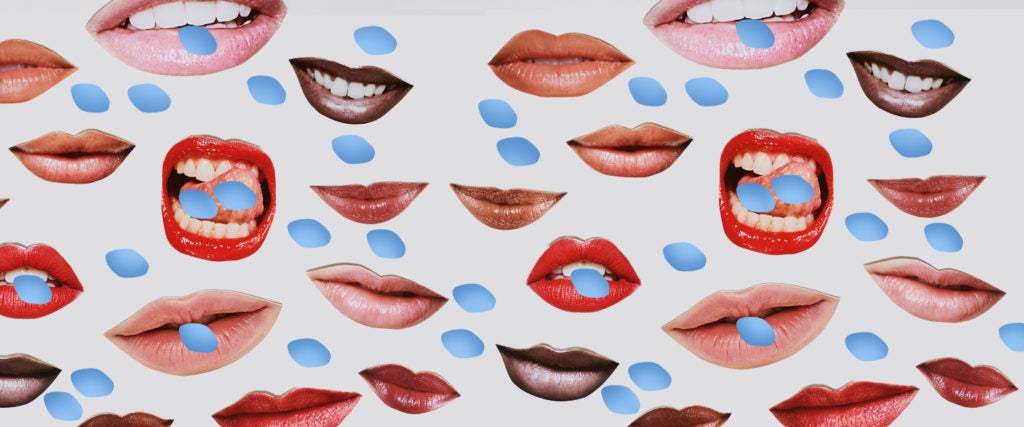Fifty-year-old Melissa remembers her first experience with the little blue pill. It began in her face. About half an hour after taking a 50-milligram tab of Viagra, her cheeks and chest started slowly heating up. She felt her features flush. Somewhat unexpectedly, she noticed congestion building in her nose, leaving her sinuses feeling blocked. It wasn’t exactly what she had in mind.
But then, the tingling began. Eventually, the warmth from her face crept its way down her body, arriving in her vulva and her clit. The effects were faint, prickly and arousing. “It felt nice, but not dramatic,” she recalls. “The tingling was pleasant, and I felt some additional sensitivity when I had sex afterwards. I wouldn’t be opposed to using it again, but it wasn’t so amazing that I’d seek it out.”
Melissa’s lukewarm experience isn’t so surprising: Viagra is targeted at men, and made specifically for penises. The iconic blue pill, otherwise known as Sildenafil, has been revolutionizing the sex lives of the phallicly impaired since it first hit the market back in 1998. It works its magic by blocking an enzyme called PDE5, which allows more blood to flow to the penis. Despite being a purely physiological treatment — it has no effects on sexual desire or mental arousal — it has successfully helped 70 percent of erectile dysfunction sufferers firm up their flagging members.
On the flip side, there is no conclusive evidence that Viagra works on people without a penis, but that hasn’t stopped them from trying it anyway. Thanks to its “miracle drug” reputation — and a misleading appearance on Sex and the City — there is still a relatively prevalent belief that women can benefit from the drug in some way. Some studies have alluded to this: One from 2003 reported a high likelihood of Viagra causing “increased blood flow to the genital area” and feelings of “warmth, tingling and fullness” when taken by post-menopausal women. Another, from 2008, found that the drug could help women on antidepressants reach climax, with 72 percent of the 98 participants claiming that the drug “improved” their sexual function (although, again, it seemed to have no effect on drive or desire).
Other studies have been rare, or conflicted in their findings. A recent example from 2014 found that, while the drug could occasionally have some effect on lubrication and orgasm in women, the changes were unlikely to be that profound. This is because women have a lower concentration of the PDE5 enzyme, meaning that blood flow in female genitalia doesn’t get affected in the same way as men.
Even the anecdotal evidence is underwhelming. While there are some accounts of vague success, like Melissa, the majority of women seem to report no difference. “I tried Viagra, but it did nothing for me,” says Brit, 29, from New York. “I was in good health at the time, no real sexual issues, and I took a full tablet. It didn’t make any difference to my orgasm — or to my arousal.”
Taking erection medication when you have a vagina was always going to be wishful thinking. The clitoris is much more complex than a penis: It’s connected to different brain regions and comes with double the nerve endings (8,000 to the peen’s humble 4,000). Unfortunately, science has a pretty terrible rep when it comes to understanding the organ, and has spent centuries deriding or dismissing its function. In the 16th century, for example, it was known as the “devil’s teat” and seen as a sign of witchcraft — a view that barely changed until the latter half of the 20th century. In fact, it took until 1981 for the medical community to publish the first anatomically correct image of a clitoris, with a detailed examination of its anatomy not coming until 2005.
Consequently, research around women’s desire obviously trails behind men’s. But in the last two decades, the pharmaceutical industry has been doing everything it can to catch up. Some might say this was a good thing; Viagra has been a lifesaver for thousands (if not millions) of flailing penises, so it’s only fair that women have their equivalent. Other motivations, however, could be more cynical: A successful “pink” Viagra would tap into an estimated billion dollar market, allowing manufacturers to monetize — and in turn, pathologize — a woman’s low sex drive.
So far, the results of this female-focused drive have been mixed. In 2015, the FDA approved Addyi — otherwise known as flibanserin — which pledges to improve women’s libido by hacking the brain and tapping into the chemical origins of sexual desire (it still isn’t clear exactly how it does this). The drug’s target audience is apparently women suffering with Hypoactive Sexual Desire Disorder, a potentially made-up term for “low sex drive.” The condition is commonly diagnosed, despite the DSM-V classifying its criteria as “obsolete.”
Either way, Addyi never really took off (even after a loud “female Viagra” marketing campaign). The little pink pill, which was rejected by the FDA twice before its approval, comes with a lot of potentially serious side effects, such as dizziness, nausea and low blood pressure. It also doesn’t really seem to work: One FDA review found only 8 to 13 percent of women felt benefits from the drug after two months of taking it daily. Cindy Pearson, the executive director of the National Women’s Health Network, told BuzzFeed at the time that the data around Addyi was “awful, just awful.”
In 2019, Addyi was joined by Vyleesi, another “brain-hacking” drug that promises to reduce inhibition and increase “neural excitation” in women (again, it isn’t entirely clear how it does this). It’s supposed to be administered via self-injection, as-needed, 45 minutes before sex. Like Addyi, the side effects are unappealing (vomiting, nausea and headaches), and the evidence unconvincing (only 8 percent of women experienced increased desire in an FDA review).
That said, it can make a difference. Pixie, 30, from Boston, found salvation in the drug after losing her libido three years into her relationship with her husband. After another four years of experimenting with antidepressants, anti-anxiety medication and CBD, she turned to Vyleesi. “I lost all interest in sex — I told my doctor I’d rather pick lint from the carpet than have it,” she says. “I tried Addyi for a year, which didn’t hurt, but it didn’t really help either. Then Vyleesi got approved, and I got it right away.”
“It’s great,” she continues. “It’s not a cure, but it’s incredibly helpful. Vyleesi helps my body remember that sex can be great and not a chore.”
Still, the success rates of Vyleesi and Addyi are nowhere near that of Viagra. So where are the pharmaceutical companies going wrong? Why is it so hard to find a “female Viagra” that actually works?
Firstly, there’s a major difference between how Big Pharma approaches sexual dysfunction in men and women. Viagra is a purely physiological drug, with no effect on mental desire and arousal; its main focus is keeping the penis hard. In the “female Viagras,” however, the attention shifts to the mental. Rather than targeting genital function or clitorial erections, the treatment of sexual dysfunction in women is all about what’s happening in the brain — e.g., alleviating anxieties and reducing inhibitions. Along those lines, Addyi was initially touted as an antidepressant before its new life as a libido enhancer.
It’s clearly a simplistic approach. “This kind of binary thinking designates women’s sexual problems primarily as mental and men’s sexual problems primarily as physical,” says Donna J. Drucker, a historian at Technical University of Darmstadt in Germany. “It does the complexity of all human sexualities a disservice.”
It’s worth emphasizing that doctors have only a basic understanding of how Addyi and Vyleesi work. Although we know that the former targets serotonin receptors and the latter activates melanocortin receptors, the long-term effects are still largely unknown (as are their potential effects on trans users on hormone replacement therapy). This murkiness, and haphazard willingness to experiment with chemical imbalances in the brain, seems to be a common theme with women’s medical treatments. After all, it took nearly six decades for the medical community to realize that “The Pill” shrunk certain brain regions and had detrimental effects on mental wellbeing.
The longer the focus is on conquering the female brain, then, the harder it will be to create a safe and viable “pink” Viagra. This is mainly because there are countless factors that can contribute to a low sex drive — from stress and diet, to depression and sexual incompatibility — which makes a one-size-fits-all cure impossible. “Sexual behavior and desire is so widely variable across times and cultures that holding anyone to an abstract idea of normalcy can do more harm than help,” Drucker explains. “Anyone considering medications should study their success rates and side effects seriously before beginning to take them.”
Luckily, there are other potentially effective treatments on the horizon. Some are already lurking out there, like the mysterious — and probably pretty dangerous! — Pink Pussycat pill. Others, which seem to put more priority on physiological effects, are in development. This includes Lybrido, an apparently “very impressive” drug that harnesses the power of both testosterone and sildenafil (the active ingredient in Viagra). There is also a topical sildenafil cream in the works, which is supposed to increase blood flow around the clitoris.
But right now, they’re all promise. How they’ll actually perform is still unclear. “Science is just perplexed that women have complex sexual responses,” Pixie concludes. “It’s mysterious. The female libido is complicated — because of course it is.”

